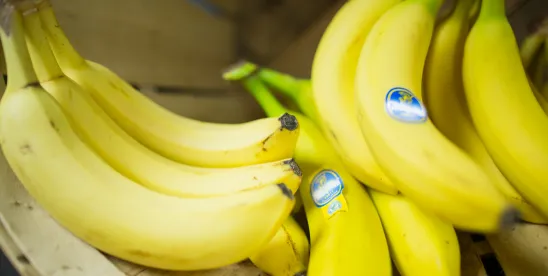In 2019, Italian artist Maurizio Cattelan[1] exhibited a new conceptual work, Comedian,[2] at Art Basel Miami. Comedian, which was widely reported (and frequently ridiculed) in both the art press and the general press, is a banana taped to the wall with gray duct tape. For decades, Cattelan’s work has been known for its irony and irreverence.[3] His works have included a solid gold toilet (titled America),[4] five taxidermied horses hung on a wall, back-side out (titled Untitled (all five horses together at once, for the first time),[5] a statue of Adolf Hitler kneeling in prayer (titled Him),[6] and a giant stone hand, reminiscent of the hand of the Colossus of Constantine in Rome’s Capitoline Museum, but with only the middle finger intact (the work, titled crippled hand, was displayed in front of the Milan stock exchange palace).[7] In an interview for The Art Newspaper, Cattelan described his intention: “To me, Comedian was not a joke; it was a sincere commentary and a reflection on what we value. At art fairs, speed and business reign, so I saw it like this: if I had to be at a fair, I could sell a banana like others sell their paintings. I could play within the system, but with my rules.”[8]
In 2020, another conceptual artist, Joe Morford, sued Cattelan in the U.S. District Court for the Southern District of Florida for copyright infringement, claiming that Cattelan had copied Morford’s 2001 work, Banana and Orange, which featured an artificial orange and an artificial banana duct-taped to green rectangular panels, the orange above the banana.[9] On June 12, 2023, the court issued its decision, granting summary judgment to Cattelan, holding that Morford had not proved that Cattelan had copied Banana and Orange.[10]
Proving Copying
While one banana duct-taped to a wall may look much like another, mere similarity is not enough to prove copyright infringement. As the court noted, for a claim of infringement, Morford would be required to show that (1) there was factual copying by Cattelan of Banana and Orange, and (2) the similarities between the two works “extend to the work’s original, protectible elements.”[11] It is the latter of these requirements that proves to be interesting and informative in this case. When it comes to a banana taped to a wall, what exactly does copyright protect?
Access
Factual copying may be shown by either direct or indirect evidence “demonstrating that the defendant had access to the copyrighted work and that there are probative similarities between the allegedly infringing work and the copyrighted work.”[12] The question of access to a copyrighted work is a specific one. A claimant must show that the defendant had “reasonable access” to the work, which requirement is not satisfied by “bare possibility”; neither can access be “inferred through mere speculation of conjecture.”[13] Morford argued that Cattelan had access to Banana and Orange because that work had been available online for years, and had been viewed (or viewable) worldwide, including in locations where Cattelan lived and worked. Cattelan, however, denied having ever seen or heard of Banana and Orange, and Morford was unable to produce evidence of any nexus to Cattelan. The court concluded that “[n]owhere is Morford able to demonstrate that Banana and Orange enjoyed any particular or meaningful level of popularity; in fact, the evidence cited supports the opposite finding, that it remained a relatively obscure work with very limited publication or popularity. Nor is Morford able to demonstrate any particular nexus between Cattelan and himself.”[14]
The Question of Legal Similarity
While the court’s holding that Cattelan lacked access to Morford’s work would have been dispositive, the court nevertheless continued, analyzing Morford’s evidence with respect to the claimed similarity between Banana and Orange and Comedian. Copyright protects only the legally distinct expressive elements of a work, not the underlying idea(s). To determine which elements (if any) of Banana and Orange were protectible expression, the court looked to the Eleventh Circuit’s “abstraction – filtration – comparison” test. Under this test, a court (1) breaks down the copyrighted work into its constituent parts (abstraction), then (2) filters out all non-protectible elements (filtration), and finally (3) compares the remaining, protected elements to the allegedly infringing work (comparison).
1. Abstraction
In the abstraction prong of the test, the court isolated the separate abstract elements of Banana and Orange. The court found the following to be the work’s abstracted elements:
Morford’s Banana & Orange features two green rectangular panels, each seemingly attached to a vertical wall by masking tape. The panels are stacked on top of each other, with a gap between each. Roughly centered on each green panel is a fruit: an orange on the top panel and a banana on the lower panel. The orange is surrounded by masking tape, and a piece of silver duct tape crosses the orange horizontally. The banana is at a slight angle, with the banana stalk on the left side pointing up. The banana appears to be fixed to the panel with a piece of silver duct tape sunning vertically at a slight angle, left to right.[15]
2. Filtration
Once a work has been broken down into its abstract elements, the court next must filter out all of those elements that are not protectible – any underlying “idea, procedure, process, system, method of operation, concept, principle, or discovery.”[16] Also filtered out are those elements where the idea can only be expressed in a single way (or very limited number of ways). This is known as the merger doctrine (where idea and expression merge). In this case, the Court held that the “banana [that] appears to be fixed to the panel with a piece of silver duct tape running vertically at a slight angle, left to right,” was “not protectible under the merger doctrine,”[17] and filtered it out of the analysis.
After filtering the various elements of Banana and Orange, the court concluded that the work had only four protectible elements: “(1) the green rectangular panel on which the fruit is placed; (2) the use of masking tape to border the panels; (3) the orange on the top panel and the banana on the bottom panel, both of which are centered; (4) the banana’s placement ‘at a slight angle, with the banana stalk on the left side pointing up.’”[18]
3. Comparison
Comparing the four protectible elements of Banana and Orange with Comedian, the court held that the works “share only one common feature that the Court has not already set aside as unprotectible: both bananas are situated with the banana’s stalk on the left-hand side of sculpture. This solitary common feature is, on its own, insignificant and insufficient to support a finding of legal copying.”[19] The remaining features, the Court held, were “simply too disparate to support a finding of substantial similarity.”[20]
Conclusion
Ultimately, the court concluded that “there is no dispute of material facts with regards to Cattelan’s lack of access to Banana and Orange, the lack of legal similarities between Comedian and Banana and Orange, and Cattelan’s proof of his independent creation of Comedian.”[21] It is common to think of conceptual art as disembodied – as just an idea. And it is perhaps also easy to think of the court’s analysis of rights in a banana taped to a wall as ridiculous. But it is sometimes helpful to reduce things to basics and analyze what may seem to be unanalyzable.
[1] See, e.g., article on Maurizio Cattelan, The Art Story.
[2] See Sarah Cascone, “Maurizio Cattelan Is Taping Bananas to a Wall at Art Basel Miami Beach and Selling Them for $120,000 Each,” ArtNet News, Dec. 4, 2019; Elise Taylor, “The $120,000 Art Basel Banana, Explained,” Vogue, Dec. 10, 2019; and Jason Farago, “A (Grudging) Defense of the $120,000 Banana,” The New York Times, Dec. 8, 2019; Sarah Cascone, “Maurizio Cattelan’s Much Adored (and Maligned) Banana Artwork Is Now in the Guggenheim’s Collection Thanks to an Anonymous Donor,” ArtNet News, Sept. 18, 2020.
[3] See Christina Elia, “Maurizio Cattelan: King of Conceptual Comedy,” The Collector, April 18, 2020.
[4] See Calvin Tomkins, “Gold Toilet,” The New Yorker, Sept. 14, 2016.
[5] See “maurizio cattelan’s 5 horses at fondation beyeler,” DesignBoom.
[6] See “Maurizio Cattelan ‘Him’”, Perrotin website.
[7] See Antonella Ciancio, “Is Cattelan giving business the finger in Milan?”, Reuters, Sept. 27, 2010.
[8] Gareth Harris, “Maurizio Cattelan: ‘Life is often tragic and comedic at the same time’”, The Art Newspaper, Nov. 30, 2021.
[9] To see both Morford’s and Cattelan’s works side by side, see Benjamin Sutton, “Florida judge squashes copyright infringement lawsuit over Maurizio Cattelan’s banana,” The Art Newspaper, June 13, 2023.
[10] Morford v. Cattelan, Case No. 21-20039-Civ-Scola, 2023 WL 3971968 (S.D. Fla. June 12, 2023).
[11] Id. at *4.
[12] Id.
[13] Id. at *5 (quoting Herzog v. Castle Rock Ent., 193 F.3d 1241, 1249 (11th Cir. 1999)).
[14] Id. at *6.
[15] Id. at *7.
[16] Id. at *8.
[17] Id. at *9.
[18] Id. at *9.
[19] Id. at *9.
[20] Id. at *9.
[21] Id. at *11.



 />i
/>i
